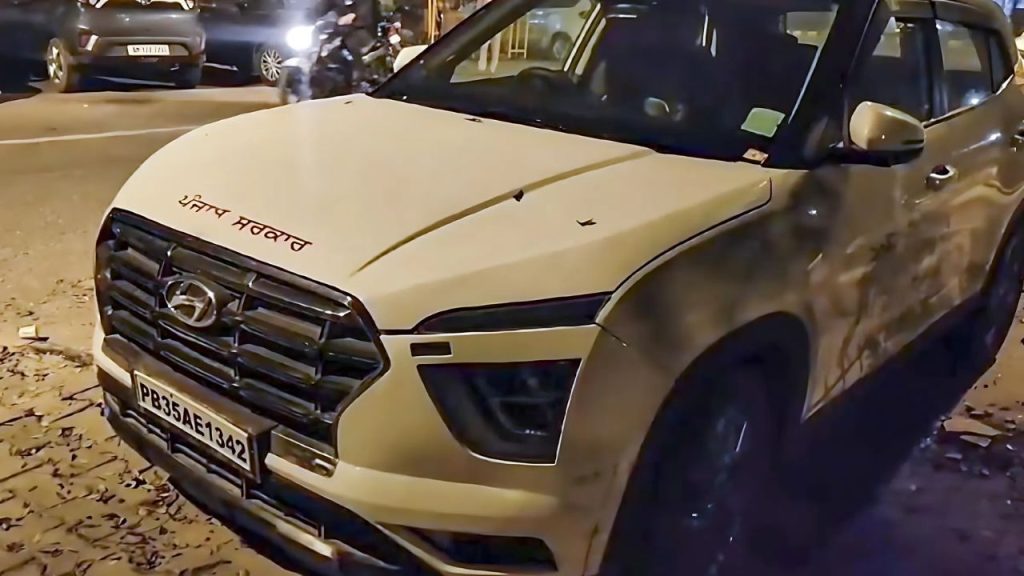
In a dramatic turn of events, the Delhi Police recently seized a vehicle prominently marked with the label “Punjab Government” that was found to be carrying large sums of cash and bottles of liquor. The vehicle’s unusual cargo and its connection to the state of Punjab have sparked a heated political debate. The Aam Aadmi Party (AAP), which is in power in Punjab, has quickly dismissed the incident as a “planted stunt” aimed at tarnishing the party’s reputation and credibility.
The Seizure
The incident unfolded when the Delhi Police, acting on a tip-off, intercepted a vehicle bearing official markings of the Punjab Government. Upon inspection, they discovered a large quantity of cash and several bottles of liquor concealed within the vehicle. The exact amount of cash and the type and quantity of liquor have not been fully disclosed by the authorities, but the discovery immediately raised suspicions of potential electoral malpractice or illicit activities.
The vehicle, as reported by the police, was in transit from Punjab to Delhi. This has triggered questions regarding the origin of the cash and liquor and whether these items were being transported for nefarious purposes. At the time of the seizure, the driver and the occupants of the vehicle could not provide satisfactory explanations regarding the contents they were carrying, further fueling speculation.
AAP’s Response
The Aam Aadmi Party (AAP), which has been in power in Punjab since 2017, was quick to react to the news. Party spokespersons, including senior leaders and ministers, swiftly dismissed the seizure as a “staged stunt.” They accused the Delhi Police, which is under the control of the central government, of attempting to discredit the AAP-led government in Punjab. According to AAP, this was part of a larger effort to defame the party ahead of important state and national elections.
The AAP’s allegations are rooted in the political rivalry between the ruling party in Punjab and the Bharatiya Janata Party (BJP), which governs at the center. The AAP leadership claims that such incidents are a deliberate attempt to create a false narrative of corruption and criminality, ultimately undermining the public trust in the Punjab government.
Political Implications
This episode has larger political ramifications. The seizure comes at a time when Punjab is grappling with significant political tensions. The AAP, under Chief Minister Bhagwant Mann, is navigating a complex political landscape, with opposition parties like the Congress and BJP often accusing the party of mismanagement and corruption. In this context, any event that casts a shadow on the AAP’s image could have significant electoral consequences.
The political dynamics in Punjab are further complicated by the ongoing influence of regional players, especially given the proximity to elections. The AAP’s ability to navigate these challenges while maintaining its image of transparency and anti-corruption is crucial for its continued political success.
The BJP, which has historically struggled to make significant inroads in Punjab, could potentially use incidents like these to bolster its position in the state. This is especially relevant as the BJP aims to challenge the dominance of regional parties like the AAP, Congress, and Shiromani Akali Dal (SAD) in Punjab.
The Allegations of ‘Planted Evidence’
The AAP’s accusation of a “planted stunt” raises concerns about the integrity of the evidence and the motivations behind the Delhi Police’s actions. The party has suggested that the items found in the vehicle were strategically placed in order to frame the Punjab government and discredit its leadership.
AAP leaders have pointed to what they perceive as discrepancies in the manner of the seizure. For instance, the party has questioned why the vehicle was marked with official Punjab Government logos when it was supposedly engaged in a suspicious activity. According to AAP, this could suggest that the vehicle was purposefully set up to look like a legitimate government transport, making the discovery more sensational and politically charged.
Additionally, the party has pointed to the timing of the event, which coincides with critical moments in both state and national political timelines. By framing this incident as a politically motivated stunt, AAP is positioning itself as a victim of systemic bias and political targeting.
The Role of the Delhi Police
The Delhi Police’s role in this matter has also come under scrutiny. While the police have followed standard procedures in seizing the vehicle and its contents, their involvement in the political dispute raises questions. The Delhi Police report to the Union Home Ministry, which is led by Amit Shah of the BJP, leading to claims of political interference.
Some analysts argue that the Delhi Police’s actions reflect the increasing politicization of law enforcement in India. The political leadership at the center has long been accused of using state apparatus to target opposition parties, and this incident appears to fit into that narrative. However, there is also a counterpoint that suggests the Delhi Police are simply carrying out their duties in investigating potential violations of the law, without any political agenda.
At the time of writing, no formal charges have been pressed against the driver or the owner of the vehicle, and the investigation is ongoing. However, the political controversy surrounding the seizure has already gained significant traction in the media, overshadowing the more technical aspects of the case.
Reactions from the Opposition
Opposition parties in Punjab and beyond have seized on this controversy to further criticize the AAP government. The Shiromani Akali Dal (SAD), a key player in Punjab’s political landscape, has called for a thorough investigation into the matter, demanding that the AAP clarify its involvement. Similarly, the Congress party, which had been a major political force in Punjab until AAP’s rise, has also demanded answers from the Punjab government.
The BJP, which has traditionally held a strong influence in Delhi, has largely remained silent on the issue. However, their allies in the state have used the incident to rally their supporters, claiming that the Punjab government has failed to uphold basic standards of governance and accountability.
Conclusion
The Delhi Police’s seizure of a vehicle marked with “Punjab Government” and carrying illicit items has sparked a heated political row, with the AAP accusing the central government of trying to frame them in a “planted stunt.” Whether or not the allegations of a staged incident hold water remains to be seen, but the political ramifications of this event are already clear. With elections on the horizon, this controversy is likely to remain in the public eye, as each party seeks to leverage the incident for political gain.
The case highlights the growing tension between national and regional political forces, particularly in states like Punjab, where the political landscape is highly polarized. As the investigation continues, the questions surrounding the legitimacy of the seizure, the role of the Delhi Police, and the motivations behind the incident will undoubtedly continue to shape the political discourse in the coming months.
